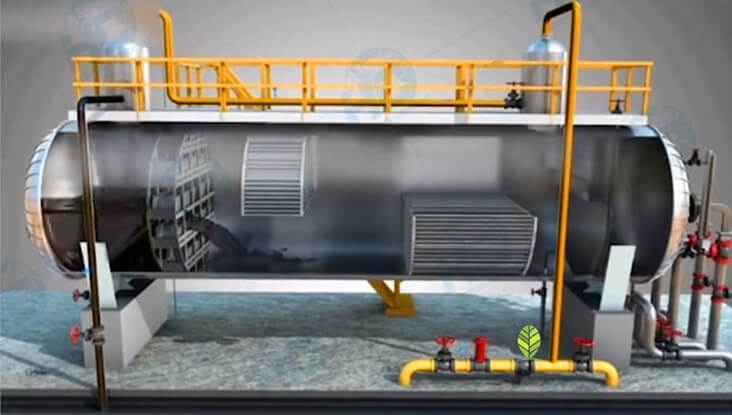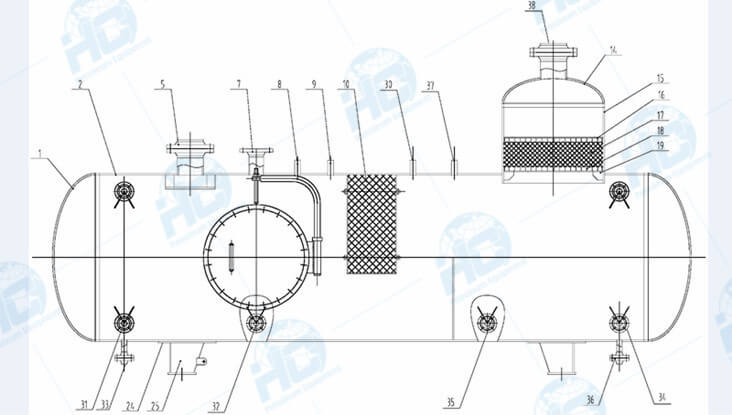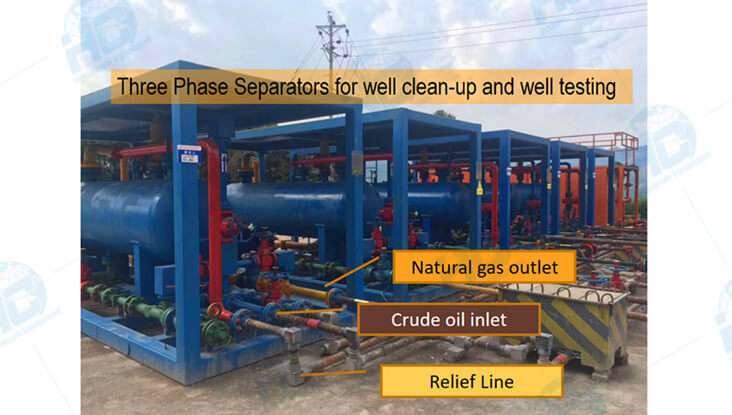High-pressure separators are essential pieces of equipment in the oil and gas industry, where their role in efficiently separating gas, oil, and water phases under high-pressure conditions directly impacts the overall success of oil field operations. As oil and gas fields continue to face the challenges of diminishing resources, operators are increasingly turning to high-pressure separators to improve the recovery efficiency of well fluids. These separators not only play an essential role in enhancing the productivity of oil and gas fields but also ensure that the separated phases—gas, oil, and water—are prepared for further treatment, facilitating a more sustainable and economically viable operation. To achieve this, understanding the working principle, design features, and application contexts of high-pressure separators is crucial for making informed decisions about their selection and use.
The Core Functionality of High-Pressure Separators in Oil and Gas Production
The primary function of a high-pressure separator is to separate the various phases of well fluids, typically gas, oil, and water, under high-pressure conditions. These separators are designed to handle fluids that emerge from deep wells or offshore fields, where the pressure of the fluid can exceed thousands of psi. The separator effectively separates the phases by relying on the differences in their respective densities. Gas, being the lightest phase, rises to the top of the separator, while the heavier oil and water phases settle at the bottom under the influence of gravity. The separator ensures that each phase is collected and discharged separately, which is vital for further processing, whether it be for oil refining, water treatment, or gas compression.
In deep well environments, the fluids often come to the surface under significant pressure, and therefore, high-pressure separators must be built to withstand these extreme conditions. The challenge lies not only in the ability of the separator to handle these pressures but also in its capacity to maintain efficiency in separating the phases despite the variations in fluid composition and flow rates. To address these challenges, high-pressure separators are designed with advanced features that enable them to perform optimally even under the most demanding operational conditions.
Principle of Separation in High-Pressure Separators
Earlier, HC discussed the Structure & Working Principle of Three-Phase Separators, and today, we will introduce the working principle of high-pressure separators. At the heart of the high-pressure separator's operation lies the principle of density-based separation. This process, which uses the differences in densities between gas, oil, and water, is fundamental to the separator's ability to divide the well fluids into their respective phases. When fluids enter the separator, the first stage of the process involves reducing the pressure through inlet nozzles designed to decrease the velocity and prevent excessive turbulence. This pressure drop allows for the initial separation of large liquid droplets from the gas phase, thus aiding the separation process.
The primary separation zone of the high-pressure separator is where the bulk of the liquid phases, which include both water and oil, begin to settle. In this zone, the incoming fluid is forced to change direction suddenly, which causes heavier liquid droplets to separate from the gas phase due to gravity. The larger liquid droplets collect at the bottom of the vessel, where they are directed toward separate outlets—one for water and another for oil.
Following this, the fluid enters the gravity separation zone, which is the core section of the separator where the fine-tuning of the separation occurs. In this zone, the velocity of both gas and liquid phases slows down considerably, allowing gravity to act more effectively in causing the liquid droplets to settle. At this stage, smaller droplets of oil and water that were not separated in the primary zone aggregate and settle due to the combined effect of gravity and buoyancy. The efficiency of this zone is crucial for ensuring that the gas phase is as pure as possible and that the liquid phases are adequately separated before they are sent for further treatment.
However, even after gravity separation, some very fine droplets of liquid can remain suspended in the gas phase. To address this, the separator incorporates a mist elimination zone, which is designed to remove these small droplets from the gas phase. The mist elimination zone typically contains mesh pads or demisting devices that force the small droplets to collide with each other and coalesce into larger droplets. These larger droplets can then be separated from the gas flow by gravity and directed to the appropriate liquid outlet.
Design Features and Considerations for High-Pressure Separators
High-pressure separators must be meticulously designed to handle the harsh conditions they are subjected to. One of the most critical factors in their design is the pressure rating, which must be sufficient to withstand the high pressures associated with deep-well or offshore production. The separator's pressure vessel is constructed from materials that are capable of enduring these high-pressure conditions, with common materials including carbon steel and alloy steels that are resistant to both corrosion and fatigue.
Another important aspect of high-pressure separator design is the flow distribution system, which ensures that the incoming well fluid is evenly distributed across the separator's internal sections. This helps to prevent the formation of surges or blockages that could disrupt the separation process. Additionally, separators often include advanced level control systems that monitor and regulate the levels of liquid within the separator to ensure smooth operation and prevent overfilling of the oil or water phases.
Safety mechanisms are another integral feature of high-pressure separators. Given the extreme conditions under which these separators operate, safety devices such as pressure relief valves, rupture discs, and emergency shutdown systems are installed to protect the equipment and the personnel operating it. These safety mechanisms are designed to release excess pressure in the event of a malfunction or system overload, thereby preventing damage to the separator and minimizing the risk of accidents.
Applications of High-Pressure Separators
High-pressure separators are used across a variety of applications in the oil and gas industry. They are particularly essential in deep-well and offshore drilling, where well fluids are brought to the surface under high pressure, requiring equipment that can handle these extreme conditions without compromising separation efficiency. In well testing operations, high-pressure separators are used to evaluate the composition of the well fluids, allowing operators to accurately measure gas, oil, and water content, which in turn helps in making decisions about further production or reservoir management.
In flowback operations, which occur after hydraulic fracturing, high-pressure separators are used to efficiently manage the mixture of fluids that return to the surface. The separator ensures that the valuable hydrocarbons are separated from water and other materials, which can then be treated or disposed of accordingly. This separation is crucial not only for recovering valuable resources but also for ensuring environmental compliance by properly managing produced water.
Choosing the Right High-Pressure Separator for Your Needs
Selecting the appropriate high-pressure separator for a given operation requires careful consideration of several factors. The most important considerations include the pressure and temperature conditions at the wellhead, the flow rates and expected volume of well fluids, and the physical properties of the fluids themselves, such as viscosity and sediment content. Customization is often necessary, as each oil and gas field presents unique challenges that must be addressed in the separator’s design.
Moreover, operators should also consider the maintenance requirements and reliability of the separator, as equipment downtime can lead to significant production losses. Opting for a separator with a proven track record of high efficiency and low maintenance can result in significant long-term savings and enhanced operational performance.
High-pressure separators play an indispensable role in oil and gas production, particularly in deep-well and offshore applications. Their ability to efficiently separate gas, oil, and water phases under extreme pressure conditions directly contributes to the overall success of oil field operations. By understanding the working principles, design features, and applications of high-pressure separators, operators can make informed decisions that enhance resource recovery, reduce operational costs, and improve safety in the field. As the demand for efficient separation technology grows, selecting the right high-pressure separator is key to maintaining competitive and sustainable operations in an increasingly challenging industry.
-
2025 / 11 / 01
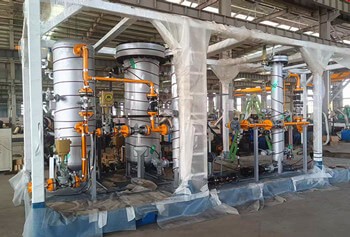 HC Successfully Delivers Gas-Liquid-Sand Separator for Xinjiang Oilfield Project
HC Successfully Delivers Gas-Liquid-Sand Separator for Xinjiang Oilfield Project -
2025 / 08 / 20
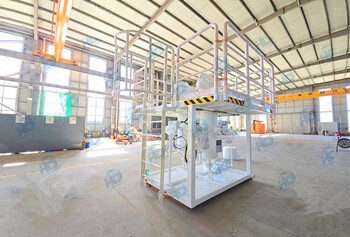 HC Successfully Delivered Filter Coalescer Skid to Malaysia
HC Successfully Delivered Filter Coalescer Skid to Malaysia -
2025 / 08 / 12
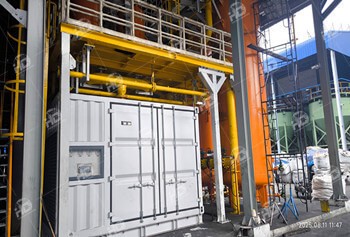 Thailand Sulfur Removal Unit Commissioned for Natural Gas Processing Plant
Thailand Sulfur Removal Unit Commissioned for Natural Gas Processing Plant
- +86 158 6190 3617








